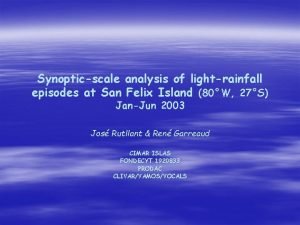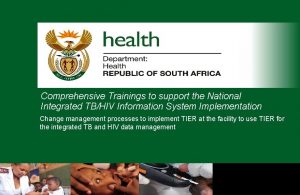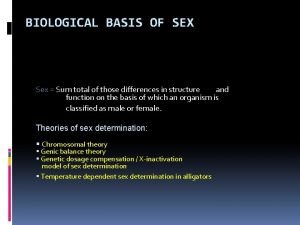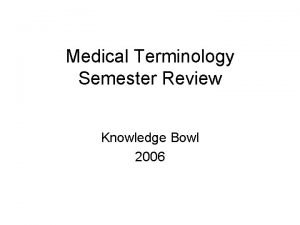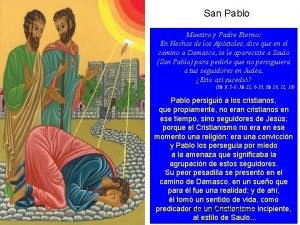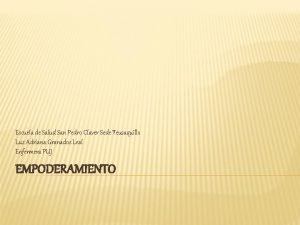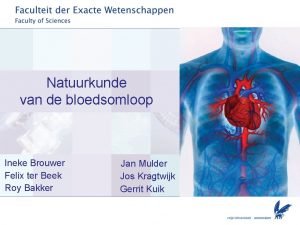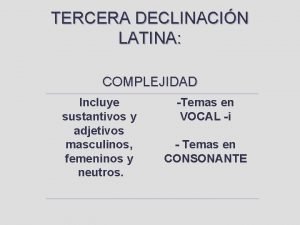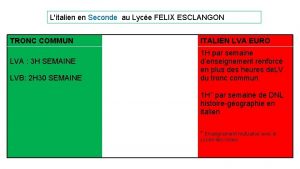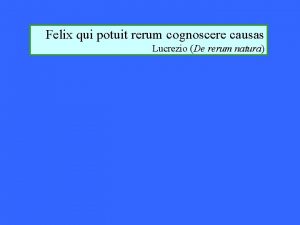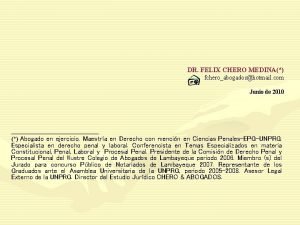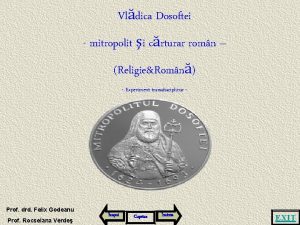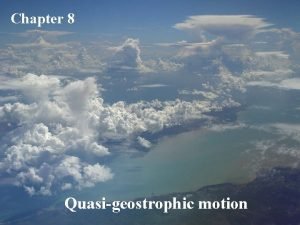Synopticscale analysis of lightrainfall episodes at San Felix




















![SAN FELIX ISLAND Precipitation Events May 2003 DAY HOUR OBS. PP[mm] CL oktas CL SAN FELIX ISLAND Precipitation Events May 2003 DAY HOUR OBS. PP[mm] CL oktas CL](https://slidetodoc.com/presentation_image/42ecf919fd70f45a1b87961ca563029f/image-21.jpg)



























- Slides: 48

Synoptic-scale analysis of light-rainfall episodes at San Felix Island (80°W, 27°S) Jan-Jun 2003 José Rutllant & René Garreaud CIMAR ISLAS FONDECYT 1920833 PRODAC CLIVAR/VAMOS/VOCALS

THE STRATOCUMULUS (Sc) CLOUD COVER § Role of subtropical Sc in global climate: radiative forcing dominated by the shortwave component: “climate refrigerator”. § A 4 % reduction in subtropical Sc cloudcover/albedo is equivalent to a 2 a 3ºC increase in the mean global surface temperature.

SUBTROPICAL STRATOCUMULUS CLOUD-COVER IN THE SUBTROPICAL SOUTH-EASTERN PACIFIC UNDER THE SOUTHEAST TRADE-WIND REGIME. SE Pacific: extensive cold-tongue spanning over eastern equatorial Pacific (ITCZ north of the equator) – – – SE trades vs. Coastline shape Subtropical anticyclone large/strong Orography // coastline. Altiplano * Coastal and equatorial upwelling, evaporation, cold-water advection. * Complex air-sea interaction processes. * Lack of observational data over the ocean >>>> FAILURE OF COUPLED MODELS TO SIMULATE THE SEASONAL CYCLE (Mechoso et al. , 1995)

September-October Climatology: * surface winds (arrows), * precipitation over 200 mm/month (orange-yellow) * stratocumulus cloud cover above 30 % (grey). * Cross-equatorial flow (westerly components downstream) east of the curved line. Adapted from EPIC (1998).

Variability in the subsidence over the stratocumulus cloud cover HIGH FREQUENCY (coastal strip): diurnal cycle of mass divergence associated with flow over the west slope of the Andes (Rutllant et al. , 1998, 2003) (subtropical SE Pacific): diurnal cycle in convection over the central Andes highlands (altiplano) (e. g. Rodwell and Hoskins, 2001 ) (subtropical SE Pacific): diurnal wave resulting from thermal/mechanical effects off the coastline/orography bent at 18 ºS (Garreaud and Muñoz, 2004) (SE Pacific). synoptic-scale disturbances including coastal lows (Garreaud et al. 2001; Garreaud and Rutllant, 2002) LOW FREQUENCY (CLIVAR) *intraseasonal cycle (MJO’s) *seasonal cycle from the Caribbean warm pool (e. g. Enfield, CP) *interanuual cyclel: ENSO *decadal/interdecadal cycles (e. g. ENSO-like) Non-linear behaviour in HIGH-FREQUENCY disturbances determine LOW FREQUENCY (CLIVAR) variability

Cross-shore section at 23ºS (Antofagasta) in austral summer afternoon Rutllant et al. , (1998, 2003) *regional atmospheric circulation (thin arrows) * ocean circulation induced by the Ekman drift (thick arrows) * Height-integrated zonal mass transport over the subsidence inversion (twin arrows) ) Coastal subssidence Inland distance in km

Mean divergence and diurnal cycle anomalies (Quikscat) (adapted from Wood et al. , EPIC 2003) • Positive mean divergence anomalies (relative to other subtropical west coasts) except at the coastal bend (18ºS). • Enhanced subsidence in the afternoon (18 L) off the coast (especially off subtropical Chile) except at the coastal bend (18ºS). Mean divergence Diurnal cycle (6 L-18 L)

“Upsidence” wave simulated with the MM 5 model (Garreaud & Muñoz 2004) • Vertical (large-scale) winds at 800 h. Pa (from 15 - day regional MM 5 simulation, October 2001) - Subsidence prevails over much of the SE Pacific during morning and afternoon (10 -18 UTC). - A narrow band of strong ascending motion originates along the coast after local noon (18 UTC) and propagates southwestward over the following 12 hours, reaching as far west as the IMET buoy (85 W, 20 S) by local midnight.

Diurnal vs. Synoptic variability (MM 5) (adapted from Garreaud & Muñoz, 2004) Diurnal amplitude in 800 h. Pa potencial temperature equals or exceeds synoptic-scale variability.

High near-shore variability Closed cells

Pockets of open-cells associated with light precipitation Robert Wood (UW)

Pocket of open cells Closed cells

Stevens et al. (2004)

Stevens et al. (2004)

Stevens et al. (2004)

CIMAR 5 Caldera – Easter Island October 1999 cruise Ceilometer Vaisala CT 12 K (RSMAS)

A A CIMAR 5 Easter Island - Robinson Crusoe Island November 1999 AGOR Vidal Gormaz

17 November 1999. R/V Vidal Gormaz steaming to A. Selkirk Is. Rain-showers to the NW. Ship under Sc with NW/6 knots winds.

On- board ceilometer Vaisala CT 12 K (weak precip. Reported between 6 and 8 UTC) 17 November 1999

300 h. Pa B SFC Ship position B B
![SAN FELIX ISLAND Precipitation Events May 2003 DAY HOUR OBS PPmm CL oktas CL SAN FELIX ISLAND Precipitation Events May 2003 DAY HOUR OBS. PP[mm] CL oktas CL](https://slidetodoc.com/presentation_image/42ecf919fd70f45a1b87961ca563029f/image-21.jpg)
SAN FELIX ISLAND Precipitation Events May 2003 DAY HOUR OBS. PP[mm] CL oktas CL type W present W past UTC Wind grad/knots 10 6 0. 2 6 3 80 8 140/18 10 12 1. 5 6 4 2 8 130/16 12 0 0. 3 7 3 80 2 130/08 12 12 0. 7 5 5 1 2 120/13 15 6 0. 1 5 3 80 2 130/15 15 12 0. 2 7 8 25 2 120/09 16 12 1. 4 7 8 25 2 150/14 20 12 trace 3 5 1 8 310/13 20 24 1. 1 0 0 1 8 270/14 23 12 0. 6 8 8 80 8 130/13 27 6 trace 8 5 2 8 130/13 27 12 0. 4 8 5 2 2 100/11 29 12 1. 2 8 7 80 6 calm


BK (22 Apr 2003) Geopotential height anomalies at 300 h. Pa SF

BK (22 Apr 2003) Geopotential height anomalies at 1000 h. Pa SF

BK (5 Jan 2003) Geopotential height anomalies at 300 h. Pa SF

BK (5 Jan 2003) Geopotential height anomalies at 1000 h. Pa SF

BH (26 Jan 2003) Geopotential heights at 300 h. Pa

BH (26 Jan 2003) Geopotential height anomalies at 300 h. Pa SF

BH (26 Jan 2003) Geopotential heights at 1000 h. Pa

BH (26 Jan 2003) Geopotential height anomalies at 1000 h. Pa SF SF

BH (4 March 2003) Geopotential heights at 300 h. Pa

BH (4 March 2003) Geopotential height anomalies at 300 h. Pa SF

BH (4 March 2003) Geopotential heights at 1000 h. Pa

BH (4 March 2003) Geopotential height anomalies at 1000 h. Pa SF

WH-T (2 June 2003) Geopotential heights at 300 h. Pa

WH-T (2 June 2003) Geopotential height anomalies at 300 h. Pa SF

WH-T (2 June 2003) Geopotential heights anomalies at 1000 h. Pa SF

SH-R (23 May 2003) Geopotential heights at 300 h. Pa

SH-R (23 May 2003) Geopotential height anomalies at 300 h. Pa SF

SH-R (23 May 2003) Geopotential height anomalies at 1000 h. Pa SF

SH-R (23 May 2003) Geopotential heights at 1000 h. Pa

Hovmoeller Diagram Geopotential heights at 500 h. Pa May 2003 SF pp > 1 mm

Preliminary Conclusions § The majority of the recorded precipitation events during the study period (43 %) at SFI correspond with low-zonal index conditions, with quasi-barotropic anticyclonic/cyclonic anomalies at high/subtropical latitudes (BK) off the chilean coast. § During tha austral summer, when the subtropical upper tropospheric circulation is mostly controlled by the South American monsoon (BH), precipitation events (26 %), seem to respond to weak disturbances in the trade- wind regime, some of them with a clear mid-latitude origin. The latter become ( WH-T) in austral autumn-winter (23 %) § Cases with a strong subtropical anticyclone and a ridge aloft ( SH-R) probably respond to mesoscale features (POC’s ? ) (9 %). § Measurable precipitation is observed mainly before noon. Most of it appears with a mixture of Cu and Sc, within a partial cloud cover.





BK BK BK
 San felix island
San felix island Parallel episode in flowers for algernon
Parallel episode in flowers for algernon Social episodes are
Social episodes are Jenny jones show killer
Jenny jones show killer Quaver's marvellous world of music theme song
Quaver's marvellous world of music theme song Anorexia vs bulimia usmle
Anorexia vs bulimia usmle Parade's end episodes
Parade's end episodes The daily episodes from
The daily episodes from Argumentum verbo sum
Argumentum verbo sum How does baba view amir’s episodes with car sickness?
How does baba view amir’s episodes with car sickness? Big bang theory episodes
Big bang theory episodes Myocele medical term
Myocele medical term Parallel episodes in flowers for algernon
Parallel episodes in flowers for algernon Msei usfca
Msei usfca Qué opinas acerca de san pedro y san pablo
Qué opinas acerca de san pedro y san pablo Ic bosco san salvatore telesino
Ic bosco san salvatore telesino Esspc
Esspc Felix just lectionary
Felix just lectionary Felix longoria
Felix longoria Felix candela
Felix candela Social work 7 principles
Social work 7 principles Ineke brouwer
Ineke brouwer Felix compen
Felix compen Felix schmutterer
Felix schmutterer Felix parra
Felix parra Felix gonzalez-torres
Felix gonzalez-torres Father of philippine pharmacophytology
Father of philippine pharmacophytology Johan felix blumfeldt
Johan felix blumfeldt Felix ter chian tan
Felix ter chian tan Bambi vrsta djela
Bambi vrsta djela Kako izgleda bambi
Kako izgleda bambi Mandy schramm
Mandy schramm Autoportrait d'un passeport juif
Autoportrait d'un passeport juif Fr felix just
Fr felix just Omnis omne declinado
Omnis omne declinado Felix carlier
Felix carlier Sebastian knitter
Sebastian knitter Beba felix
Beba felix Lycée felix esclangon
Lycée felix esclangon Rerum cognoscere causas
Rerum cognoscere causas Felix chero
Felix chero The treasure of lemon brown climax
The treasure of lemon brown climax Félix lópez sánchez
Félix lópez sánchez Felix godeanu
Felix godeanu Felix
Felix Felix horch
Felix horch Felix wu uc davis
Felix wu uc davis Felix evensen
Felix evensen Felix just
Felix just
